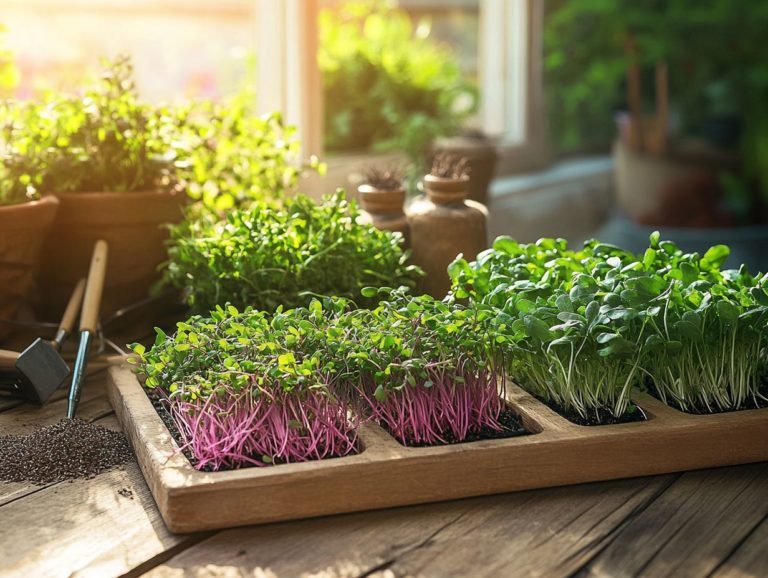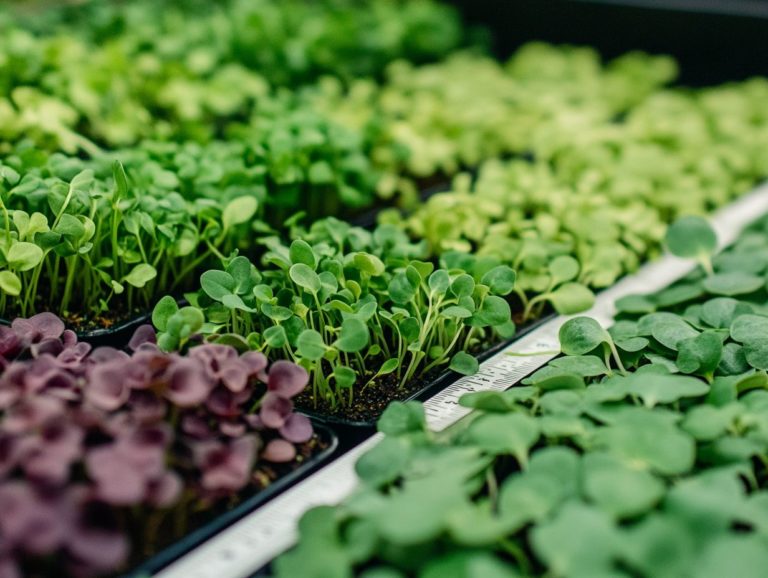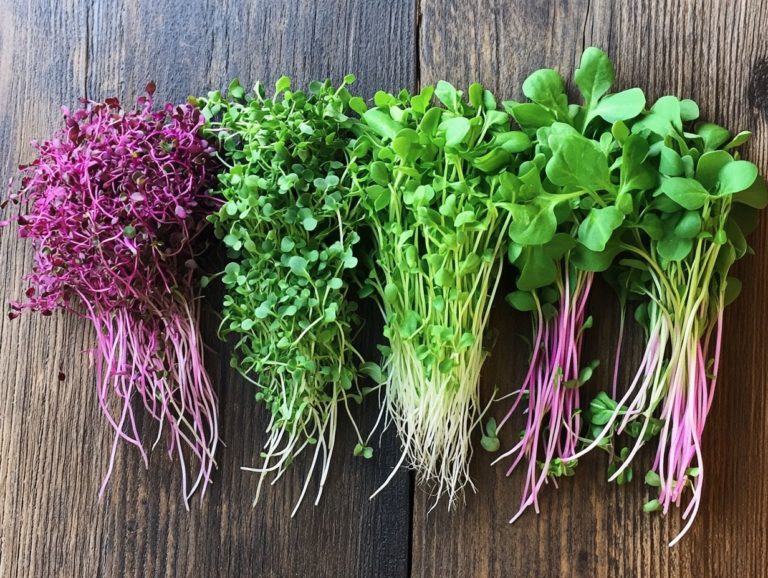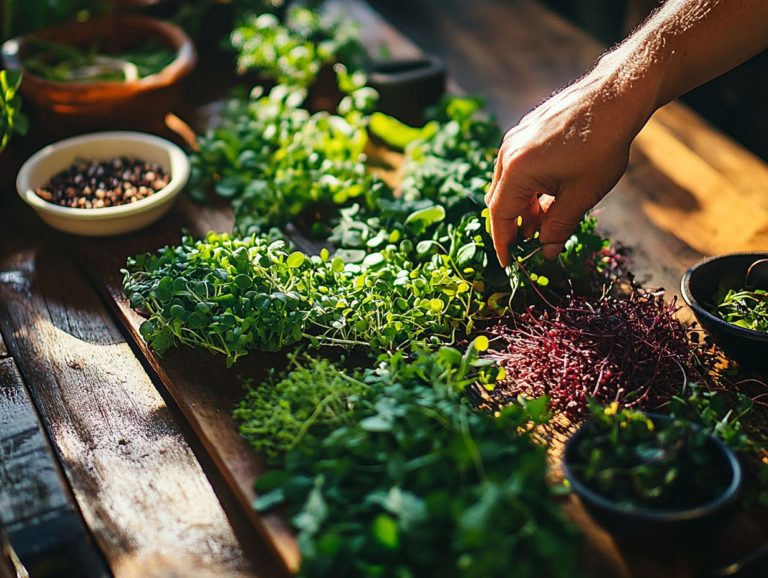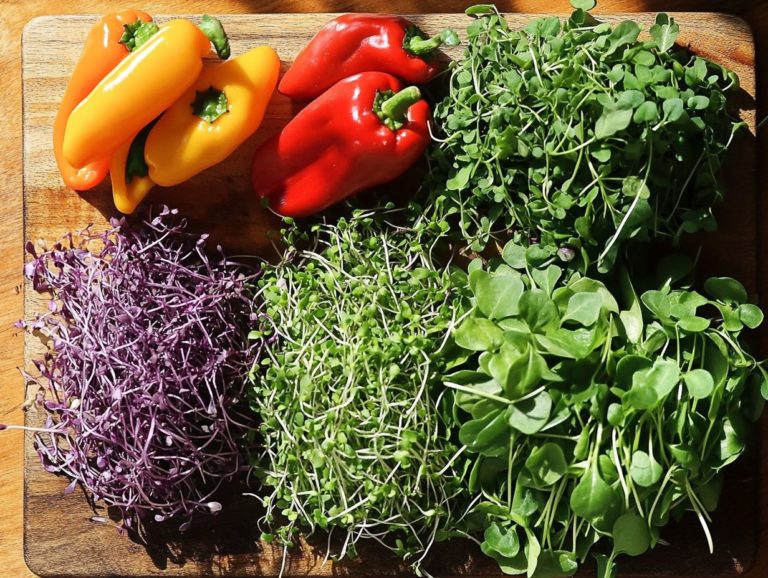How to Create a Microgreen Variety Garden
Microgreens are tiny powerhouses of nutrition, bursting with flavor and health benefits! They make an exceptional addition to your garden.
This guide explores the many advantages of cultivating a microgreen variety garden. You ll learn about their remarkable nutritional value and environmental benefits.
Discover how to choose the best varieties for your space, prepare your garden, and successfully grow microgreens and harvest these delectable greens.
Find inventive ways to incorporate microgreens into your meals and troubleshoot any challenges you may face. Whether you re an experienced gardener or just beginning your journey, this information will ignite your passion and inspire you to nurture your own flourishing microgreen garden!
Contents
- Key Takeaways:
- Benefits of Growing a Microgreen Variety Garden
- Choosing the Right Varieties for Your Garden
- Preparing Your Garden for Microgreens
- Growing and Harvesting Microgreens
- Creative Ways to Use Microgreens
- Troubleshooting Common Issues
- Frequently Asked Questions
- 1. What are microgreens and why should I create a variety garden with them?
- 2. How do I get started with creating a microgreen variety garden?
- 3. Can I create a microgreen variety garden indoors?
- 4. How often should I water my microgreens in a variety garden?
- 5. What are some popular microgreens for a variety garden?
- 6. Can I harvest microgreens more than once in a variety garden?
Key Takeaways:

- Microgreens are packed with nutrients and have numerous environmental benefits.
- When selecting varieties for your garden, consider factors such as growing time, flavor, and space constraints.
- Proper soil preparation, water management, and harvesting techniques, like scissors harvesting, are crucial for successful microgreen growth.
What are Microgreens?
Microgreens are delightful young plants that you can harvest just after their first true leaves emerge. They deliver a vibrant burst of flavor and an impressive concentration of nutrients compared to their mature counterparts.
Think of varieties like broccoli, arugula, mustard, chia, sunflower, and buckwheat; these tiny greens are packed with antioxidants, polyphenols, and essential vitamins like C and K, along with vital minerals such as potassium, iron, and magnesium. You can grow them in various environments, making them a versatile addition to your home garden!
The growth process of microgreens is captivatingly swift, often taking just a week or two from seed to harvest. This means you can enjoy fresh produce in no time! Unlike fully matured plants, microgreens deliver a nutrient punch that can be up to 40 times greater than their larger vegetable counterparts.
This makes them an exceptional choice for boosting your vegetable intake while adding a splash of color and texture to your dishes.
Incorporating these tiny greens into your meals can elevate flavors and support health benefits like improved digestion and immune function. They re not just a garnish; they re a delightful and healthful enhancement to any culinary adventure!
Benefits of Growing a Microgreen Variety Garden
Cultivating a microgreen variety garden enriches your diet with a plethora of health benefits and elevates the biodiversity and environmental sustainability of your home garden.
These tiny powerhouses are packed with essential vitamins and minerals, significantly enhancing your vegetable intake. By embracing microgreens, you take an active role in reducing waste and promoting eco-friendly gardening practices.
It’s a win-win for your health and the planet, encouraging practices like windowsill gardening and organic soil use!
Nutritional Benefits
Microgreens are a treasure trove of health benefits, delivering a remarkable nutritional punch in their petite forms. These tiny greens boast significantly higher levels of antioxidants, polyphenols, vitamins C and K, along with essential minerals like potassium, iron, and magnesium all vital for maintaining your overall health!
These nutrients play crucial roles in various bodily functions, from bolstering your immune system to enhancing bone strength and promoting radiant skin. The antioxidants in microgreens work tirelessly to combat oxidative stress, a factor linked to chronic diseases. Meanwhile, the generous vitamin K content supports blood clotting and bone metabolism, while the abundance of vitamin C aids in collagen formation and immune defense.
Incorporating microgreens into your diet is a simple yet effective strategy to elevate your vegetable intake, especially beneficial for those aiming to enhance their nutritional profile without complicating their meals. Versatile and easy to use, these greens can be effortlessly tossed into salads, blended into smoothies, or used as garnishes, enriching your everyday diet without a hitch!
Ready to start your own microgreen garden? Get growing today!
Environmental Benefits
Growing microgreens in your home garden brings a wealth of environmental benefits. This contributes to sustainable practices and significantly reduces food miles. You can cultivate these vibrant plants using organic methods, which minimizes chemical usage while fostering biodiversity and supporting local food systems.
What’s even better is that these little greens require very few resources; they thrive with minimal water and space. Their rapid growth cycle means you can harvest them in as little as two weeks. For those interested in cultivating them, check out this guide on how to grow microgreens in small containers. This makes them an efficient choice for anyone who craves fresh produce without the need for sprawling plots.
By embracing microgreens, you not only elevate your culinary repertoire but also play a crucial role in the movement toward sustainable agriculture. This practice nurtures a profound connection with nature and local ecosystems. To get started, check out this guide on how to start a microgreen garden for beginners. You will be part of a new generation of environmentally-conscious gardeners dedicated to preserving our planet.
Choosing the Right Varieties for Your Garden

Selecting the ideal microgreen varieties for your garden is crucial for enhancing flavor, nutrition, and your overall gardening experience. Consider your dietary preferences, the growing medium you plan to use, and the specific environmental conditions of your home garden.
Thoughtful consideration of these factors will lead to a successful and truly rewarding crop.
Factors to Consider
When selecting microgreens for your garden, keep several key factors in mind to ensure successful growth. Pay attention to your choice of growing medium, manage your water effectively, and evaluate your available space whether that s small containers or windowsills.
Choosing the right growing medium is essential, as it influences both drainage and nutrient retention. These are vital for your plants’ health. Incorporating techniques like seed soaking can further enhance germination rates, ensuring that your seedlings are robust and ready to thrive.
Water management is equally crucial. Over- or under-watering can lead to stunted growth or disease, turning your gardening efforts into a struggle rather than a joy. Selecting an appropriate container size supports root health and significantly impacts your overall yield.
Create an environment with adequate light and temperature for the vitality of your microgreens. By doing so, you set the stage for a flourishing growth habitat that makes your gardening experience all the more rewarding.
Preparing Your Garden for Microgreens
Preparing your garden for microgreens requires a meticulous approach. Focus on both soil preparation and seed selection to establish a robust foundation for a flourishing crop.
By opting for organic soil and ensuring an optimal germination process, you significantly enhance the health and nutrient density of your greens. To learn more about starting this journey, check out our guide on how to grow microgreens in your kitchen. This sets the stage for a truly bountiful harvest.
Soil Preparation and Seed Selection
Soil preparation and seed selection are vital steps in your journey to successfully grow microgreens. Using organic soil is your best bet for nutrient-rich results. By using pre-soaked seeds, you can significantly enhance germination rates. This ensures that your microgreens develop quickly and healthily.
When creating the perfect growing medium, consider a blend that promotes moisture retention while still allowing for adequate drainage. Organic soil offers the added advantage of beneficial microorganisms. These assist in breaking down nutrients and making them available for your plants.
Regularly check and maintain the proper pH, ideally around 6.0 to 6.5, to optimize nutrient uptake. Feed the soil periodically with organic fertilizers to ensure robust growth. Pre-soaking your seeds not only speeds up germination but also boosts their chances of a successful start. To learn more about enhancing your yield, check out this guide on how to extend the growing season for microgreens. This leads to a vibrant and thriving microgreen crop.
Growing and Harvesting Microgreens
Successfully growing and harvesting microgreens requires a thoughtful approach, encompassing a series of steps that guarantee optimal growth and flavor, leading up to the perfect harvest time.
You’ll want to manage water with precision, ensure excellent air circulation, and utilize artificial lighting when needed. These practices foster a robust germination process that yields vibrant, flavorful microgreens. For more insights, explore techniques for growing microgreens year-round.
Step-by-Step Guide

The step-by-step guide for growing microgreens lays out the key steps that will lead you to a thriving crop, including good water management and the art of determining the perfect harvest time.
Techniques like scissors harvesting using scissors to cut the microgreens for harvest can elevate both your experience and the yield of your microgreen garden. To further enhance your gardening skills, explore how to use hydroponics for microgreens.
To kick off your microgreen adventure, begin by selecting high-quality seeds that align with your taste preferences, such as arugula or sunflower. Once you’ve sown the seeds, keeping the soil consistently moist is crucial; water gently to avoid over-saturation. For those interested in maximizing their space, check out this guide on how to grow microgreens in a small space. Monitor their growth daily to catch any issues like mold or insufficient light.
When your microgreens reach about two inches tall, they’re generally ready for harvest. This is where those trusty scissors come into play for a precise cut. By embracing these practices, you align yourself with successful gardening techniques, ensuring a bountiful and gratifying harvest. For more tips, check out this guide on how to maximize yields from microgreens.
Creative Ways to Use Microgreens
Microgreens can be seamlessly woven into a variety of meals and recipes, elevating both flavor and nutrition in an array of dishes.
Whether you choose to sprinkle them on salads, layer them in sandwiches, blend them into smoothies, or use them as elegant garnishes, microgreens enhance your culinary creations with fresh, vibrant flavors and essential nutrients.
Incorporating Microgreens into Meals and Recipes
Incorporating microgreens into your meals offers a delightful crunch and an explosion of flavor while enhancing the nutritional value of your dishes. These tiny greens can be integrated into salads, sandwiches, soups, and even as toppings for pizzas, showcasing their remarkable versatility.
For example, imagine a refreshing mixed greens salad elevated by radish microgreens for a peppery kick. Meanwhile, a classic Caprese salad transforms with the inclusion of basil microgreens, boosting both taste and nutrition. In soups, just a sprinkle of pea shoots introduces a sweeter note and a burst of vibrant color. If sandwiches are your thing, layering in sunflower microgreens delivers a delightful crunch and rich flavor without overshadowing other ingredients. To start growing these delicious additions at home, check out this step-by-step guide to sowing microgreens.
Such creative uses maximize the potential of these superfoods and inspire you to experiment and uncover your own favorites in the kitchen. To enhance your microgreens experience, learn how to rotate crops for microgreens and start using them in your meals today to experience the delightful flavors they bring!
Troubleshooting Common Issues
Troubleshooting common issues while growing microgreens is vital for achieving a thriving and abundant crop. By pinpointing challenges like insufficient lighting, inadequate air circulation, or the pitfalls of over- or under-watering, you can easily fix these issues for better results!
This proactive approach ensures the health of your plants and elevates the overall success of your gardening endeavors.
Identifying and Solving Problems
Identifying and addressing issues in microgreen cultivation requires your keen observation and a thorough understanding of plant needs, particularly regarding air circulation (the movement of air around your plants) and artificial lighting. Signs like wilting, discoloration, or sluggish growth can be your clues that something s amiss. Act now to secure your microgreen harvest and ensure successful yields!
To troubleshoot these indicators effectively, evaluate the environmental conditions carefully. Proper air circulation is essential; it helps reduce the risk of mold and pests that thrive in stagnant air. Strategically placing fans around your growing area enhances airflow, ensuring your plants enjoy a breath of fresh air.
Never underestimate the importance of balanced artificial lighting. Insufficient light can lead to leggy growth or pale leaves, both far from ideal. By using grow lights positioned at the right distance and on an appropriate timer, you can maximize exposure while avoiding heat stress (a condition that can damage your plants due to excessive warmth).
Paying attention to these details cultivates a healthier microgreen environment, ultimately leading to vibrant and robust growth.
Frequently Asked Questions
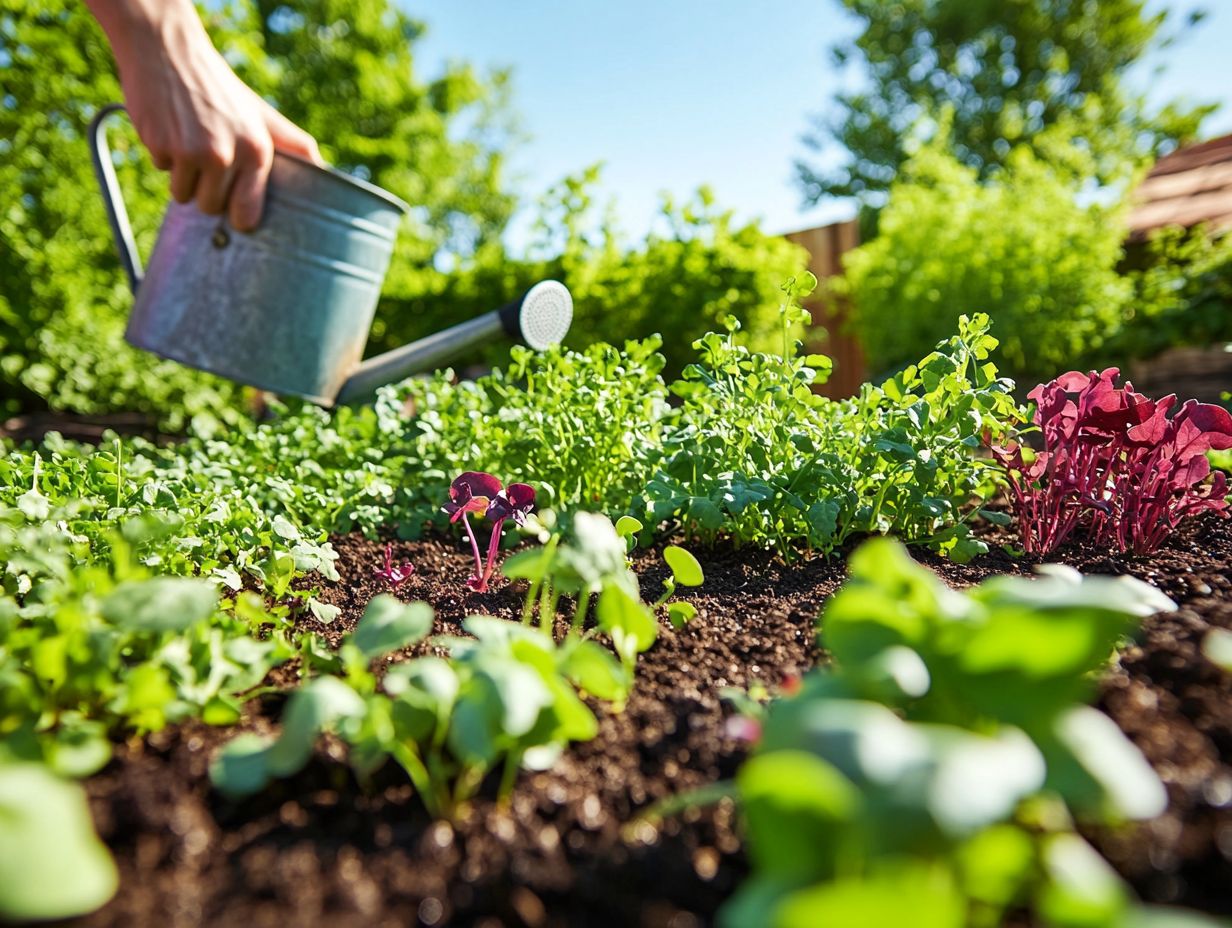
1. What are microgreens and why should I create a variety garden with them?
Microgreens are young, edible plants harvested at an early stage of growth. They are packed with nutrients and are easy to grow, making them a popular choice for home gardens. By creating a garden with a variety of microgreens, you can enjoy a diverse range of flavors, textures, and health benefits.
2. How do I get started with creating a microgreen variety garden?
The first step is to gather your supplies, including seeds, trays, potting soil, and a light source. Decide which microgreens you would like to grow and research their specific growing requirements. Finally, plant the seeds and provide them with proper care as they grow.
3. Can I create a microgreen variety garden indoors?
Yes, you can easily create a microgreen garden indoors! You will need a well-lit area, such as a windowsill or grow light, and proper ventilation. Indoor gardens are a great way to have fresh microgreens year-round.
4. How often should I water my microgreens in a variety garden?
The frequency of watering will depend on the specific microgreens you are growing and the temperature of your growing environment. As a general rule, keep the soil moist but not waterlogged. Check the soil regularly and water as needed to prevent it from drying out.
5. What are some popular microgreens for a variety garden?
Some popular microgreens for a variety garden include broccoli, kale, radish, sunflower, and pea shoots. Other options include arugula, cilantro, and mustard greens. Experiment with different varieties to find your favorites!
6. Can I harvest microgreens more than once in a variety garden?
Yes, many microgreens can be harvested multiple times. After the initial harvest, leave a small amount of growth to allow the plant to continue growing. You can typically harvest microgreens two to three times before replanting.
Get started with your microgreen variety garden today and enjoy the benefits of fresh, nutritious greens!

